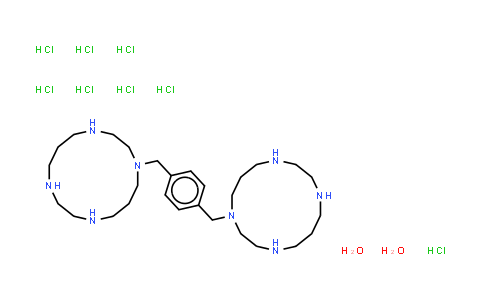
Plerixafor (octahydrochloride) NLT 98%
SKU : MC527241
CAS Number : 155148-31-5
Molecular Formula : C28H66Cl8N8O2 | Molecular Weight : 830.50
Synonyms : AMD3100 (octahydrochloride);JM3100 (octahydrochloride);SID791 (octahydrochloride)
Quote Request| Purity | NLT 98% |
|---|---|
| Storage | at 20ºC 2 years |
* The above information is for reference only.
* If the product has intellectual property rights, a license granted is must or contact us.
| Chemical Name | Plerixafor (octahydrochloride) |
|---|---|
| CAS Number | 155148-31-5 |
| MDL Number | MFCD00927130 |
| Molecular Formula | C28H66Cl8N8O2 |
| Molecular Weight | 830.50 |
| Synonyms | AMD3100 (octahydrochloride);JM3100 (octahydrochloride);SID791 (octahydrochloride) |
Plerixafor octahydrochloride (AMD3100 octahydrochloride) is a selective CXCR4 antagonist with an IC50 of 44 nM. IC50 & Target: IC50: 44 nM (CXCR4)[1] In Vitro: The CXCR4 inhibitor Plerixafor (AMD3100) is a potent inhibitor of CXCL12-mediated chemotaxis (IC50, 5.7 nM) with a potency slightly better than its affinity for CXCR4. Treating the cells with CCX771 or CXCL11 has no effect on CXCL12-mediated MOLT-4 or U937 TEM. In contrast, 10 μM Plerixafor inhibits CXCL12-mediated TEM in both cells lines[1]. Plerixafor (10 μM)-treated cells show a moderate reduction in cell proliferation compared to CXCL12-stimulated cells, which do not reach statistical significance[2]. In Vivo: Plerixafor (2 mg/kg) administration to UUO mice exacerbates renal interstitial T cell infiltration, resulting in increased production of the pro-inflammatory cytokines IL-6 and IFN-γ and decreased expression of the anti-inflammatory cytokine IL-10[3]. Both perivascular and interstitial fibrosis are significantly reduced by the CXCR4 antagonist, Plerixafor (AMD3100) at 8 weeks[4]. LD50, mouse, SC: 16.3 mg/kg; LD50, rat, SC: >50 mg/kg; LD50, mouse and rat, IV injection: 5.2 mg/kg.
Related Products
© Copyright 2015-2024 Hangzhou MolCore BioPharmatech Co.,Ltd. All rights reserved.
